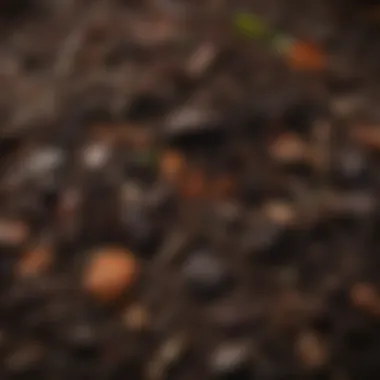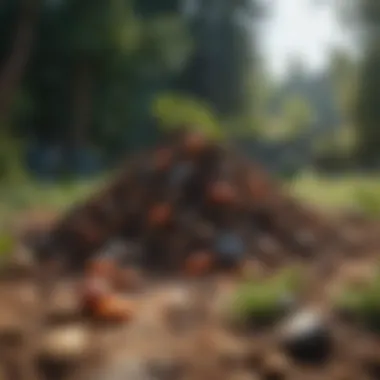Mastering the Art of Composting: A Complete Guide for Eco-Enthusiasts


The Art of Composting
Composting is a sustainable practice that holds significant benefits for the environment and soil health. It revolves around the transformation of organic waste into a nutrient-rich fertilizer, thereby reducing waste and enriching the earth. This guide aims to delve into the intricacies of composting, from foundational principles to advanced techniques. Whether you are a novice embarking on your composting journey or a seasoned composter looking to refine your skills, this comprehensive guide offers valuable insights and practical tips to aid you on this eco-conscious path.
Understanding the Basics
Before diving into the specifics of composting, it is crucial to grasp the fundamental principles that underpin this process. Composting involves the decomposition of organic matter by microorganisms, culminating in the creation of humus-rich soil amendment. The key components for successful composting include a proper balance of green (nitrogen-rich) and brown (carbon-rich) materials, adequate aeration, moisture levels, and optimal temperature. Understanding these basic factors sets the foundation for effective composting practices.
Selecting a Composting System
Choosing the right composting system is paramount to successful composting. There are various methods available, such as traditional composting bins, tumbler composters, vermicomposting (using worms), and bokashi composting. Each system has its own set of benefits and considerations, catering to different household needs and space constraints. By selecting the most suitable composting system, you can streamline the composting process and maximize efficiency.
Building Your Compost Pile
Constructing a well-balanced compost pile is essential for optimal decomposition and nutrient retention. Layering green and brown materials in the right proportions, maintaining proper moisture levels, and turning the pile regularly to promote aeration are key steps in building a healthy compost pile. Attention to detail in the composting process ensures the breakdown of organic matter into rich compost that fuels soil fertility and plant growth.
Monitoring and Troubleshooting
Continuous monitoring of your compost pile's progress is vital to identify any potential issues and ensure smooth composting. Common problems like unpleasant odors, excessive moisture, or slow decomposition can be mitigated through proactive monitoring and adjustments. By troubleshooting effectively and implementing corrective measures promptly, you can maintain an efficient composting system and produce high-quality compost for your gardening needs.
Utilizing Your Compost
The culmination of the composting process leads to the creation of nutrient-dense compost that can be utilized in various ways. Whether enriching garden soil, nourishing plants, or revitalizing depleted landscapes, compost represents a valuable resource in sustainable gardening practices. Understanding the diverse applications of compost empowers you to harness its full potential and contribute to a greener, more environmentally conscious ecosystem.
Conclusion
Introduction to Composting
Composting is a sustainable practice that holds immense significance in the realm of environmental conservation and soil enrichment. Within this comprehensive guide on how to compost, the section of 'Introduction to Composting' acts as a foundational pillar, shedding light on the fundamental principles and processes involved in this eco-friendly endeavor. By delving into the nuances of composting, readers are poised to grasp the essence of transforming organic waste into a valuable resource for their gardens and landscapes.
What is Composting?
Definition of Composting:
The crux of composting lies in the natural process where organic matter decomposes to form nutrient-rich soil amendments. This method stands out for its ability to convert kitchen scraps, yard waste, and other biodegradable materials into a potent fertilizer that fosters plant growth and soil health. The essence of composting's definition lies in harnessing the power of decomposition to create a sustainable cycle of nutrient regeneration.
Importance of Composting:
Understanding the importance of composting unveils a plethora of benefits for both the environment and individual gardeners. Composting serves as a sustainable waste management solution, diverting organic matter from landfills and mitigating greenhouse gas emissions. Moreover, the enriched soil resulting from composting nourishes plants with essential nutrients, fostering healthier growth and resilience against diseases. The significance of composting in this guide underscores its role in promoting eco-conscious practices and cultivating thriving gardens.
Benefits of Composting
Environmental Benefits:


The environmental advantages of composting are multifaceted, ranging from reducing landfill pressure to curbing methane emissions. By composting organic waste, individuals contribute to the conservation of natural resources and the minimization of greenhouse gas production. This sustainable practice exemplifies a proactive approach towards waste reduction and environmental stewardship.
Nutritional Benefits for Plants:
Compost serves as a natural plant food, enriching the soil with vital nutrients like nitrogen, phosphorus, and potassium. The nutritional benefits of compost for plants manifest in improved soil structure, water retention, and microbial activity, enhancing overall crop yield and quality. Incorporating compost into garden beds enhances the vitality of plants and establishes a harmonious ecosystem where nutrients are recycled and utilized effectively.
Getting Started with Composting
Getting started with composting is a crucial initial step in the journey towards sustainable waste management and soil enrichment. By understanding the fundamentals of composting, individuals can contribute significantly to environmental conservation. This section will delve into the essential aspects of setting up a composting system and knowing the right materials to kickstart the process effectively.
Setting Up Your Compost Bin
When it comes to setting up your compost bin, one of the key factors to consider is choosing the right location. The location of your compost bin plays a vital role in the success of the composting process. Opting for a spot that receives adequate sunlight, is easily accessible, and allows for proper aeration is essential. The chosen location should promote the decomposition of organic matter efficiently while preventing any potential hazards. Additionally, ensuring that the area is convenient for regular maintenance activities is crucial for sustained composting success.
On the other hand, selecting the appropriate bin type is equally critical for efficient composting. Whether opting for a traditional bin, tumbler, or pile system, each bin type has its unique advantages. Consider factors such as available space, the volume of organic waste generated, and ease of turning the compost when selecting the bin type. The chosen bin should be durable, adequately insulated, and user-friendly to support the composting process effectively.
Compostable Materials
Distinguishing between green and brown materials is essential for successful composting. Green materials rich in nitrogen help speed up the decomposition process, while brown materials high in carbon provide structure and aeration. Achieving the right balance between green and brown materials is crucial to maintain a healthy compost pile. Understanding the role of each material type and their contribution to the overall decomposition process is key to producing nutrient-rich compost.
Furthermore, having a comprehensive list of suitable items for composting is essential to avoid introducing harmful substances into the compost pile. While kitchen scraps, yard waste, and natural fibers are excellent additions, certain items such as pet waste, dairy products, and plastics must be avoided. It is imperative to follow a prescribed list of suitable items to ensure the quality and safety of the compost produced.
Maintaining Your Compost
Maintaining Your Compost is a critical aspect of composting that ensures the ongoing decomposition of organic materials into nutrient-rich soil conditioner. It involves regular attention to key factors that facilitate the breakdown process and prevent unpleasant odors or issues. By consistently monitoring and adjusting these elements, you can optimize the composting environment for maximum efficiency and results. Taking care of your compost through proper maintenance not only benefits your garden but also contributes to reducing waste.
Turning and Aerating
Turning and aerating are fundamental tasks in the composting process that play a crucial role in enhancing decomposition and oxygen circulation within the pile. These actions help create a balanced environment for beneficial microbes to thrive and break down organic matter effectively. Continuous turning prevents the compost from becoming compacted, allowing airflow and accelerating decomposition.
Frequent Turning
Frequent turning involves regularly mixing the compost pile to distribute moisture and oxygen evenly. This action introduces fresh nutrients and organic materials to organisms, promoting a faster breakdown process and preventing the formation of anaerobic zones. By turning the compost pile every few days, you can maintain optimal conditions for microbial activity and decomposition, ultimately resulting in high-quality compost for your garden.
The key characteristic of frequent turning is its ability to accelerate the composting process significantly. This method is popular among composters due to its efficacy in speeding up decomposition and producing nutrient-rich compost efficiently. Despite its labor-intensive nature, frequent turning ensures consistent aeration and uniform decomposition throughout the pile, making it a preferred choice for enthusiasts seeking fast results.
Importance of Aeration
Aeration is essential for the success of composting, as it facilitates the growth of aerobic microorganisms that thrive in oxygen-rich environments. Proper aeration prevents the formation of foul odors and promotes the breakdown of organic materials into stable humus. By incorporating sufficient oxygen into the compost pile, you create conditions that support diverse microbial communities and accelerate the composting process.
The key characteristic of aeration is its role in fostering aerobic conditions within the compost pile, promoting the activity of beneficial bacteria and fungi. This technique is popular among composters for its ability to produce high-quality compost with minimal odor and nutrient loss. While excessive aeration can lead to moisture loss, maintaining a balanced approach ensures an optimal environment for microbial activity and decomposition.
Monitoring Moisture Levels


Monitoring moisture levels is crucial for ensuring the proper breakdown of organic materials in the compost pile. The ideal moisture content creates a habitat that facilitates microbial growth and decomposition while preventing the pile from becoming too wet or dry. By routinely assessing and adjusting moisture levels, you can optimize the composting process and avoid potential issues such as slow decomposition or the development of anaerobic conditions.
Ideal Moisture Content
Ideal moisture content refers to the perfect balance of water within the compost pile, typically ranging between 50% to 60%. This moisture level provides sufficient hydration for microbial organisms to thrive and break down organic matter effectively. Maintaining ideal moisture content fosters optimal conditions for decomposition, ensuring a steady transformation of waste materials into nutrient-rich compost.
The key characteristic of ideal moisture content is its ability to support microbial activity and decomposition without leading to waterlogging or nutrient leaching. This optimal moisture level is a popular choice among composters for achieving efficient and effective decomposition outcomes. By consistently monitoring and adjusting moisture content, you can create a moisture balance that promotes the activity of microorganisms and enhances the quality of the compost produced.
Tips for Adjusting Levels
Adjusting moisture levels is essential to maintain the ideal conditions for composting. By incorporating certain practices such as adding dry materials to soak up excess moisture or wetting the pile with a sprinkle of water, you can regulate moisture levels effectively. These adjustments help prevent the compost from becoming too soggy or dry, ensuring that microbial activity continues uninterrupted.
The key characteristic of tips for adjusting levels is their practicality in managing moisture content to support composting processes optimally. These tips offer valuable strategies for maintaining the ideal balance of moisture within the compost pile, fostering an environment conducive to decomposition. While overwatering can impede aeration and nutrient retention, following these adjustment techniques enables you to fine-tune moisture levels and promote efficient composting outcomes.
Advanced Composting Techniques
In the realm of composting, advancing your techniques can significantly impact the quality and efficiency of your composting process. This section delves into the innovative methods that can elevate your composting game.
Hot Composting
Process and Benefits
Hot composting involves accelerating the decomposition process by maintaining higher temperatures within the compost pile. This method facilitates the breakdown of organic matter at a faster rate, resulting in compost that is rich in nutrients and free from weed seeds. The key characteristic of hot composting is its ability to reach temperatures between 135-160°F, creating an environment where microorganisms thrive and break down materials effectively. Hot composting stands out as a popular choice for individuals seeking a quicker composting turnaround time and desiring nutrient-rich compost for their gardens. Despite the advantages, it's crucial to monitor temperatures closely to prevent overheating, which can harm beneficial microbes.
Maintaining Optimum Temperature
Optimal temperature maintenance is crucial in hot composting to ensure the process remains efficient and successful. By regularly monitoring and adjusting the temperature within the compost pile, composters can optimize the activity of microorganisms responsible for decomposition. Sustaining temperatures within the ideal range promotes thorough breakdown of materials and prevents the proliferation of pathogens. The unique feature of maintaining optimum temperature lies in its direct correlation to the speed and effectiveness of the composting process. While it offers the advantage of faster compost production, inadequate temperature control can lead to imbalanced compost and hinder overall compost quality.
Vermicomposting
Introduction to Worm Composting
Vermicomposting, also known as worm composting, introduces the concept of using earthworms to break down organic matter. This method is highly efficient in converting kitchen scraps and garden waste into nutrient-rich compost. The key characteristic of vermicomposting is the involvement of specific species of earthworms that expedite the decomposition process and enhance the quality of compost produced. Vermicomposting gains popularity due to its ability to produce compost faster than traditional methods while enriching it with beneficial microbes essential for soil health. However, proper maintenance and care for the worms are necessary to prevent issues like overcrowding or unsuitable living conditions.
Creating a Worm Bin
Establishing a suitable worm bin is fundamental to the success of vermicomposting. The key characteristic of a worm bin is its design tailored to the needs of earthworms, ensuring optimal living conditions for efficient composting. This method offers the benefit of being space-efficient and manageable for indoor composting, making it an attractive choice for urban composters or individuals with limited outdoor space. The unique feature of creating a worm bin lies in its ability to sustain a balanced environment for the worms, promoting healthy decomposition processes and minimizing potential odor concerns. However, it's essential to maintain the bin's moisture levels and provide adequate aeration to support the worm population and prevent stagnation in compost production.
Using Compost in Your Garden
The section 'Using Compost in Your Garden' is a pivotal part of this expansive guide to composting. It illuminates the crucial role that compost plays in enhancing both the health of your garden and the environment. By using compost in your garden, you can significantly contribute to sustainability and plant nourishment. The benefits extend beyond basic soil health, fostering an ecosystem where plants thrive naturally. This section delves into pertinent details on how compost enriches the soil, aids plant growth, and complements your gardening endeavors.
Benefits for Soil Health


Enhancing Soil Fertility
Discussing the facets of 'Enhancing Soil Fertility' provides a deep dive into a key element that using compost in your garden offers. Enhancing soil fertility is essential for promoting robust plant growth and sustaining a healthy garden environment. The primary characteristic of this aspect lies in its ability to rejuvenate depleted soils, infusing them with essential nutrients vital for plant development. This feature sets it apart as a popular choice in this article, emphasizing its intrinsic benefits for cultivating rich and fertile soils beneficial for various plants. The unique aspect of 'Enhancing Soil Fertility' is its capability to improve soil's nutrient content naturally, maintaining a balanced ecosystem that supports plant vitality.
Improving Soil Structure
Exploring the notion of 'Improving Soil Structure' sheds light on another critical component of using compost in your garden. The key characteristic of this aspect underscores its role in enhancing soil texture, drainage, and aeration, pivotal for plant root health and overall growth. This is a favored choice in this article due to its significant impact on creating optimal conditions for plant root development and water retention within the soil. The unique feature of 'Improving Soil Structure' is its capacity to mitigate soil compaction, promoting root penetration and nutrient absorption, factors crucial for sustainable garden management.
Application Tips
Ideal Application Time
Delving into the specifics of 'Ideal Application Time' reveals essential insights into maximizing the benefits of compost in your garden. Identifying the perfect timing for applying compost is key to reaping its full potential in enhancing soil health and plant productivity. The key characteristic of this aspect is its strategic application during peak growing seasons or before planting to optimize nutrient uptake. This choice is favored in this article for its significant impact on promoting healthier plants and improving overall garden yield. The unique feature of 'Ideal Application Time' is its ability to synchronize with plant growth phases, ensuring timely nourishment and sustaining vibrant plant growth.
Precautions and Best Practices
Exploring 'Precautions and Best Practices' offers indispensable guidance for utilizing compost effectively in your garden. Understanding the fundamental precautions and adhering to best practices is paramount to avoid potential pitfalls and maximize the benefits of compost application. The key characteristic of this aspect lies in its emphasis on maintaining a balance between compost usage and plant requirements, preventing over-fertilization and its consequences. This choice is favored in this article for its practical significance in promoting sustainable gardening practices and ensuring long-term soil health. The unique feature of 'Precautions and Best Practices' is its focus on tailored approaches to compost application, aligning with specific plant needs and environmental considerations to achieve optimal results.
Troubleshooting Common Composting Issues
When delving into the realm of composting, understanding how to troubleshoot common issues becomes paramount. It acts as a foundation for ensuring a smooth composting process, allowing for the effective transformation of organic waste into nutrient-rich fertilizer. Troubleshooting common composting issues is essential for maintaining the health of your compost pile and preventing any roadblocks that may hinder its progress. By addressing issues promptly, composters can optimize their composting efforts and achieve desirable results.
Odor Problems
Causes of Odors
Addressing the causes of odors within a compost pile is crucial to maintaining a pleasant composting experience. Various factors contribute to unpleasant smells, such as an imbalance in green and brown materials, inadequate aeration, or excessive moisture levels. These factors can lead to the production of foul odors, deterring composters and affecting the overall composting process. Recognizing the sources of odors allows composters to take corrective actions and restore a healthy balance within the compost pile.
In-depth analysis of the causes of odors reveals the significance of proper material ratios, sufficient aeration, and moisture management in odor prevention. Understanding how different materials decompose and interact can help in addressing odor issues effectively. By identifying and mitigating the specific causes of odors, composters can maintain a harmonious decomposition process and ensure the production of high-quality compost.
Tips for Prevention
To prevent odor problems in a compost pile, certain strategies can be employed to promote a favorable composting environment. Implementing a proper balance of green and brown materials, regular turning or aerating of the pile, and monitoring moisture levels are key preventive measures. These practices aid in eliminating anaerobic conditions that cause odors and facilitate the breakdown of organic matter.
Effective odor prevention techniques involve proactive management of the compost pile, ensuring optimal conditions for decomposition. By following guidelines for odor prevention, composters can create a productive composting environment free from unpleasant smells. Incorporating these preventive tips into composting routines contributes to successful composting outcomes and enhances the overall composting experience.
Pest Infestations
Identifying Common Pests
The identification of common pests that may infiltrate a compost pile is essential for preserving its integrity and preventing potential damage. Common pests such as flies, ants, or rodents can disrupt the composting process and pose challenges to composters. Recognizing the signs of pest infestations and understanding their behavior patterns enables composters to take timely action and safeguard their compost pile.
Detailed knowledge of common pests, their habitats, and feeding preferences enhances pest detection and management within the composting system. By familiarizing themselves with the characteristics of prevalent composting pests, composters can implement targeted pest control strategies and maintain the health of their compost pile. Vigilance in identifying common pests is key to preserving the quality of compost and nurturing a flourishing composting environment.
Natural Pest Control Methods
Incorporating natural pest control methods offers eco-friendly alternatives for deterring pests from infesting a compost pile. Utilizing natural substances like diatomaceous earth, neem oil, or beneficial nematodes can help repel pests effectively without harming the environment. These methods serve as sustainable pest management solutions that align with the principles of organic composting.
The benefits of natural pest control methods lie in their non-toxic nature and ability to target specific pests while maintaining the health of beneficial organisms in the compost pile. By integrating natural pest control measures into composting practices, composters can mitigate pest infestations and promote a healthy ecosystem within their compost pile. Embracing these eco-conscious approaches to pest control fosters a harmonious relationship between composters, pests, and the environment.



